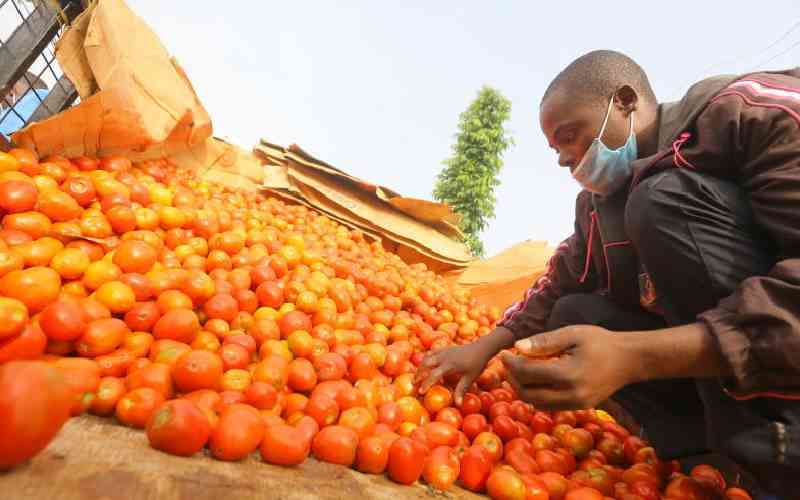Copyright standardmedia

Joseph Sheikh sorts out tomatoes at Riosiri Market in Kisii County. Prices of numerous daily essentials have surged, offering no respite to consumers. [File, Standard] Kenyans are ending 2025 significantly worse off than a year ago, with the cost of a basket of essential goods from food to transport having risen sharply, according to official data. The findings pile pressure on President William Ruto’s administration to ease the financial burden on households following its pledge to lower the cost of living. The Kenya National Bureau of Statistics (KNBS) reports the annual consumer price inflation held steady at 4.6 per cent in October, the same rate as in September. However, this headline figure masks a deeper, more painful reality for families. An analysis by The Standard of the KNBS data shows that over the past 12 months, the prices of numerous daily essentials have surged, offering no respite to consumers. The most severe pain has been in the food basket, a category that carries the heaviest weight in the consumer price index, eroding purchasing power and stretching budgets to breaking point. The “Food and Non-Alcoholic Beverages” division recorded an eight per cent year-on-year increase. Staple items saw dramatic jumps. The price of sugar skyrocketed by 22.6 per cent while the cost of sifted maize flour and fortified maize flour—a national staple—rose by 16.4 per cent and 16.5 per cent respectively. Tomatoes became 37.3 per cent more expensive, a crippling increase for a key ingredient in many local dishes. The data also showed substantial annual increases for kale (15.4 per cent), cabbage (20.3 per cent), and onions (12.0 per cent). “The price increase was primarily driven by a rise in prices of items in the food and non-alcoholic beverages (eight per cent), transport (4.8 per cent), and housing, water, electricity, gas and other fuels (1.9 per cent) over the one year,” the KNBS report stated, noting these three categories account for over 57 per cent of household spending. Beyond the supermarket, the cost of moving around has also climbed. The “transport” division saw a 4.8 per cent annual inflation rate. While pump prices for petrol and diesel remained unchanged month-on-month, they were still 2.3 per cent higher than in October 2024. The most staggering increase in this category was for local flights, with ticket prices soaring by 52 per cent over the year. Housing and energy costs provided little relief. Though the “Housing, Water, Electricity, Gas and Other Fuels” index rose by a more modest 1.9 per cent annually, the devil was in the details. The cost of electricity for a 200 kWh (unit) consumption rose from Sh5,728.40 in October 2024 to Sh5,764.15 in October 2025. Month-on-month, these charges saw a sharp rise of three per cent, indicating recent upward pressure. The report also highlighted increases across a wide range of other goods and services, painting a picture of broad-based inflationary pressures. Health costs rose 2.8 per cent over the year, while expenses for clothing and footwear (2.9 per cent), and alcoholic beverages and tobacco (3.1 per cent) also outpaced the headline inflation rate. “Between September and October 2025... the price of spirits rose by 0.1 per cent, while cigarettes recorded a 0.4 per cent increase,” the report noted, showing that even non-essential discretionary spending was becoming more expensive. The KNBS data separates inflation into “core” and “non-core” components, with core inflation excluding volatile items such as food and energy. In October 2025, core inflation eased to 2.7 per cent, but the more volatile non-core inflation, heavily influenced by food prices, accelerated to a significant 9.9 per cent. The contribution to the overall inflation figure was stark. “Core inflation contributed 2.8 points, while non-core inflation contributed 1.8 points to the overall inflation,” the bureau reported. The “food and non-alcoholic beverages” category alone was responsible for 2.6 percentage points of the total 4.6 per cent inflation rate, underscoring its dominant role in the cost-of-living crisis. While the month-on-month inflation rate was a minimal 0.2 per cent in October, this offers little comfort. The slight decrease in the prices of some food items like maize flour and kale from September to October does little to offset the massive annual increases that have left families financially bruised. With the festive season approaching, Kenyan families will be hoping for lower prices as we head into next year. However, the latest data confirms that, overall, Kenyans are worse off than they were just one year ago. The relentless climb in the cost of living piles further pressure on President Ruto’s government, which came to power promising to uplift the poor and curb economic hardship. As essential commodity prices continue to outpace wage growth for many, the administration faces a mounting challenge to deliver on its pledge to lower the cost of living and provide tangible economic relief to millions of struggling households.



